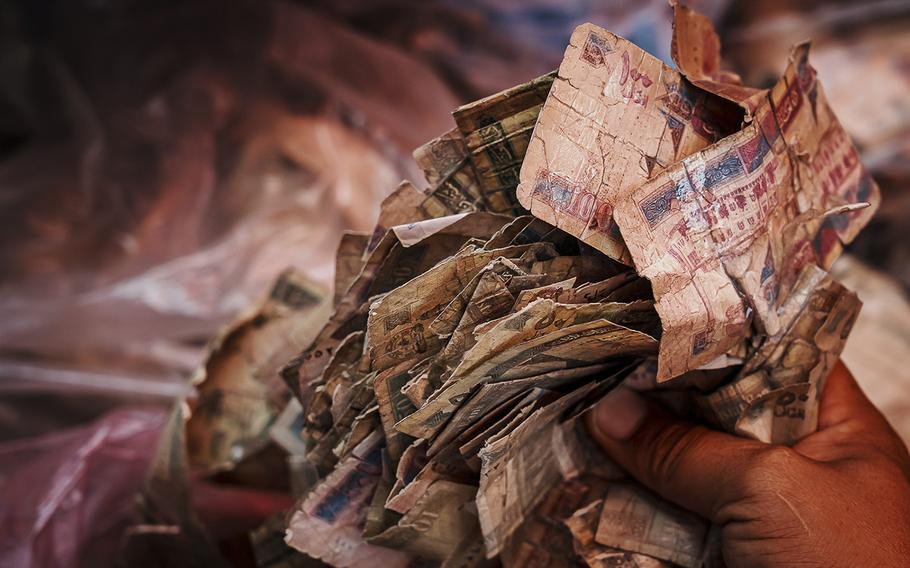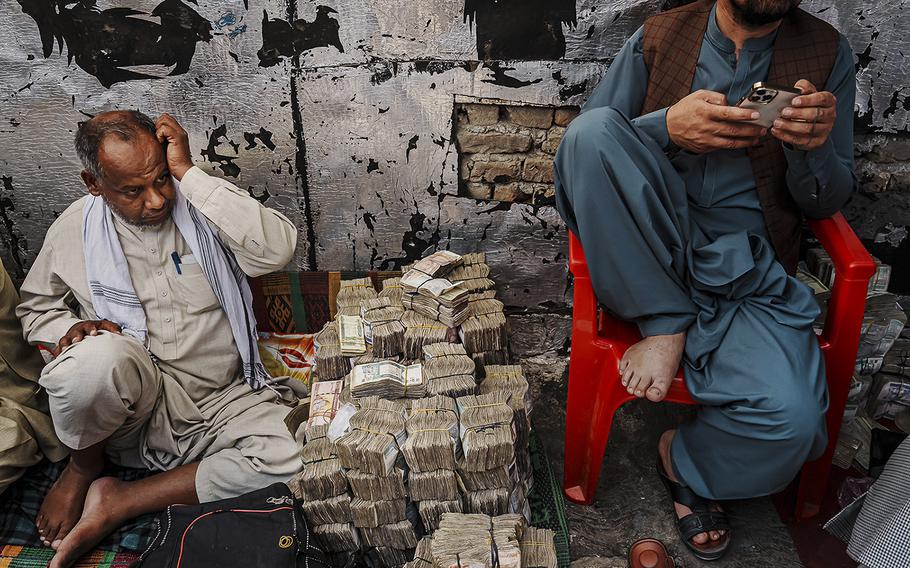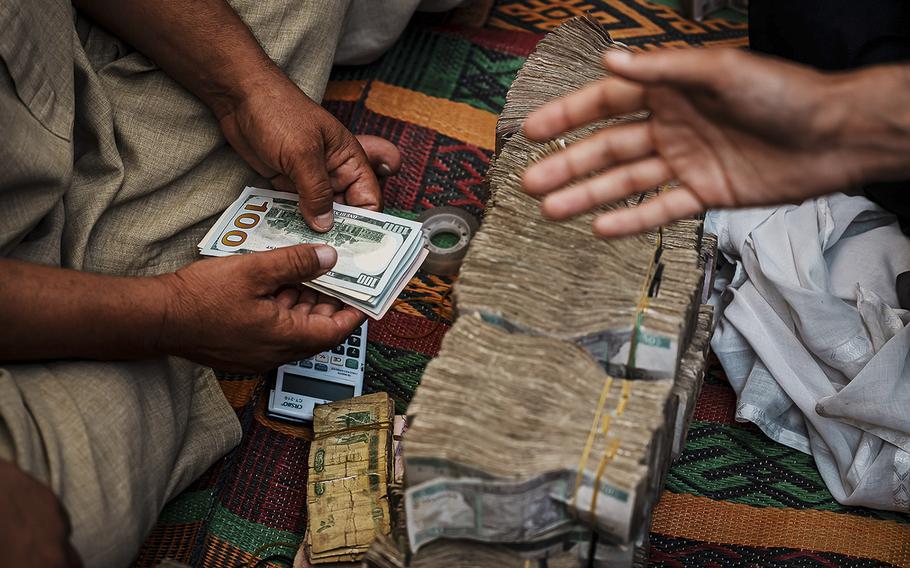
A currency converter displays a pile of extremely worn out Afghan currency at the Sarai Shahzadah, Kabul’s currency exchange market, in Kabul, Afghanistan, on Sept. 7, 2022. (Marcus Yam/Los Angeles Times/TNS)
KABUL, Afghanistan (Tribune News Service) — Remember cash? These days, when a wave of a phone or credit card gets you a cup of coffee or more, it’s easy to forget what actual bills look like — and the abuse they receive in an average five-year life span.
Not for Allah Mohammad Araya. In a country so sanctioned that much of its own cash is out of reach, he sat cross-legged in a corner of Kabul’s main foreign-exchange market, sifting through a pile of what looked like paper trash but was actually a disaster area of distressed afghanis, Afghanistan’s currency.
“Out of every 10,000 afghani bills here, maybe 1,000 of those bills are still OK to use,” he said, pointing to a 100-afghani note faded to the point that one side seemed plain. Another looked more Scotch tape than bill. A third wasn’t much better, the victim of a bad cut-and-paste job that left its color scheme — and serial numbers — mismatched.
“That one even the central bank won’t take,” he said, shaking his head before putting it up to the sun for a closer look.
A year after the Taliban careered into power, Afghanistan’s economy remains in crisis. The slashing of international aid gouged 45% out of the country’s GDP, and the World Bank and the International Monetary Fund expect economic output to contract by a further one-third by the end of 2022. Half of the country’s 39 million people need humanitarian assistance, according to the United Nations.
Making matters worse, wide-ranging Western sanctions and Washington’s freeze of $7 billion in Afghan central bank assets deposited in the Federal Reserve Bank in New York mean that credit card and online payments are out. That has turned Afghanistan into a cash-only economy not only at a time when capital controls limit how much money you can withdraw from the bank but also when no new bills are entering into circulation to replace worn-out ones.
In previous years, the Afghan central bank — known as Da Afghanistan Bank, or DAB — would withdraw annually 3 billion to 4 billion afghanis’ worth (about $33 million to $45 million) of decrepit banknotes and substitute them with new ones printed abroad. (Afghanistan does not have its own mint.) But the international sanctions on working with the Taliban have left foreign printers spooked, plunging the country into a liquidity crisis as Afghans contend with a currency that is — literally — falling apart.
“The condition of these bills, it’s terrible, and it’s getting worse by the day,” said Amin Jan Khosti, a veteran member of the money-changers union and chief of the foreign-exchange market, the Sarai Shahzadeh. “People try to iron them, they play with serial numbers. We’ve told DAB, and we know they’re trying to find solutions.”
In January 2020, the then-Republic of Afghanistan had contracted the state-owned Polish Security Printing Works, or PWPW, to print 380 million banknotes equaling 10 billion afghanis for a contract worth more than $4 million. By the time of the Taliban takeover, PWPW had fulfilled 70% of the contract, said Shah Mohammad Mehrabi, a Washington-based member of the Afghan central bank’s governing board who was appointed by the previous government but continues serving under the Taliban.
“The last tranche was supposed to be delivered last September. But it was suspended when the interim Taliban administration came into power and sanctions were imposed,” Mehrabi said.
Talks between DAB and the U.S. State and Treasury departments resulted in assurances to the PWPW that it wouldn’t run afoul of proscriptions. “But then we had logistical problems,” Mehrabi said. “Who would deliver these afghanis to the central bank?”

Money exchangers organize their stacks of Afghan currency and await customers at the Sarai Shahzadah, Kabul’s currency exchange market, in Kabul, Afghanistan, on Sept. 7, 2022. (Marcus Yam/Los Angeles Times/TNS)
Even Qatar, which has facilitated the Taliban’s diplomatic efforts, balked at doing that without Western assurances. According to Mehrabi, the Treasury Department stated that “clearance has been granted to all entities,” but an agreement between Qatar and DAB didn’t materialize.
And there was yet another issue: DAB had no intermediary through which it could send payments, including to PWPW.
“Whenever DAB tried to make payment to PWPW through another intermediary, the payment was rejected,” Mehrabi said, adding that a new contract with the French company Oberthur Fiduciaire for 390 million banknotes, negotiated by the previous Afghan government, has yet to be signed.
The consequences of the bill shortage are compounded by the overall increase in prices, which have risen in part because of the ripple effects of the war in Ukraine, said Philippe Kropf, head of communications for the United Nations’ World Food Program in Afghanistan.
People need more cash to pay for basic goods, but the amount of available hard currency is shrinking.
“We’re injecting $55.8 million every month in cash to beneficiaries, commercial transporters, food suppliers and salaries,” he said. “But money physically failing exacerbates problems with cash-based transfer. Now we tell our beneficiaries to examine the money they’re receiving and make sure it’s OK.”
You can almost see the currency degrade in real time at the Sarai Shahzadeh marketplace, a grime-encrusted, ramshackle building that on occasion gets choked with the miasma of sewage from the nearby Darya-e-Kabul river.
Inside are labyrinthine passageways with hundreds of foreign-exchange offices and swarms of currency brokers. Many gather on the rooftop, which functions as an open-air currency auction site and includes a cafeteria serving French fries and egg sandwiches, not far from where Araya, the trader who was sifting through old notes, sat on his rug under an umbrella.
He flipped idly through a bunch of 100-afghani notes — each worth about $1.13 — before settling on a particularly sorry example. He bent close to examine its production date.
“These are supposed to last roughly three years,” he said, a rueful smile on his face. “This one has been around for 14.”
On the other side of the rooftop was Qudratullah Mohammadi, a kind-faced man ensconced behind nine rubber-band-bound stacks of ragged afghanis.
“Tens, 20s, 50s, 100s — they’re the worst,” he said, gesturing toward his reject pile. “I argue with people, I fight with them, but most won’t accept these bills” when they try to convert foreign currency into afghanis.
“I’m saving them for the day the central bank will take them,” Mohammadi said.
The aversion to lower-denomination bills affects transactions in the other direction as well, said Faiz Zaland, a professor of political science at Kabul University. Currency traders impose a penalty on customers exchanging lower-denomination afghanis for foreign cash because the central bank refuses to accept them.
“You’ll get one rate if you give them 1,000- and 500-afghani notes, but with 10s and 50s you have to pay more,” Zaland said.
Some have tried to circumvent the banking system entirely by using cryptocurrencies, which had a surge in popularity after the Taliban takeover. A report by data firm Chainalysis saw Afghanistan vault to 20th out of 154 countries in crypto adoption; a year earlier it hadn’t even warranted a ranking.
Turning that into money in hand is a convoluted process. One method has been to use bitcoin to purchase Universal Cash, one of the currencies used in the massively popular online game PlayerUnknown’s Battlegrounds, or PUBG. That can then be sold on to a number of exchange houses for hard cash.
But the Taliban recently imposed a nationwide ban on digital currency trading. In August, local media reported that authorities shut down 16 cryptocurrency exchange houses in the western province of Herat.
“When the price of bitcoin more than halved, the (government) decided to stop it all. They shut down some people here,” said Mohammad Mansour, a currency trader with an office in a side warren of the Sarai Shahzadeh.
Others believe the Taliban’s moves indicate it’s in no hurry to resolve the liquidity crisis.

Money exchangers exchange Afghan currency for U.S. dollars at the Sarai Shahzadah, Kabul’s currency exchange market, in Kabul, Afghanistan, on Sept. 7, 2022. (Marcus Yam/Los Angeles Times/TNS)
“The incentive to not having enough money in the market is that your exchange rate stays high against the U.S. dollar,” Zaland said. It took 77 afghanis to buy $1 in early 2021, but now it takes about 88 — a smaller depreciation of the afghani than expected.
In any case, talks are largely frozen for now: Following a U.S. drone strike on a house in Kabul that killed al-Qaida leader Ayman al-Zawahri in July, Washington paused discussions with DAB, Mehrabi said.
This month, the State and Treasury departments issued a joint statement announcing the establishment of the Switzerland-based Afghan Fund, which “will protect, preserve, and make targeted disbursements” of half of the frozen reserves, using the $3.5 billion to stabilize the Afghan economy while keeping the money “out of the hands of the Taliban and other malign actors.”
The statement said that, to rebuild confidence internationally, DAB needs to show it is free from political interference, has “appropriate” anti-money laundering and terrorism financing controls and submits to third-party assessment and monitors.
It all adds up to a major headache for Abdul Qaher Faqiri, a Kabul-based businessman with projects involving importing goods and mining. Leaning back in his chair, he took a worn-out 20-afghani note from his wallet.
“Afghanistan is like our money,” he said, turning the bill over to examine the multitude of tears and the discoloration from years of use. “It’s all a big, big problem.”
©2022 Los Angeles Times.
Visit latimes.com.
Distributed by Tribune Content Agency, LLC.